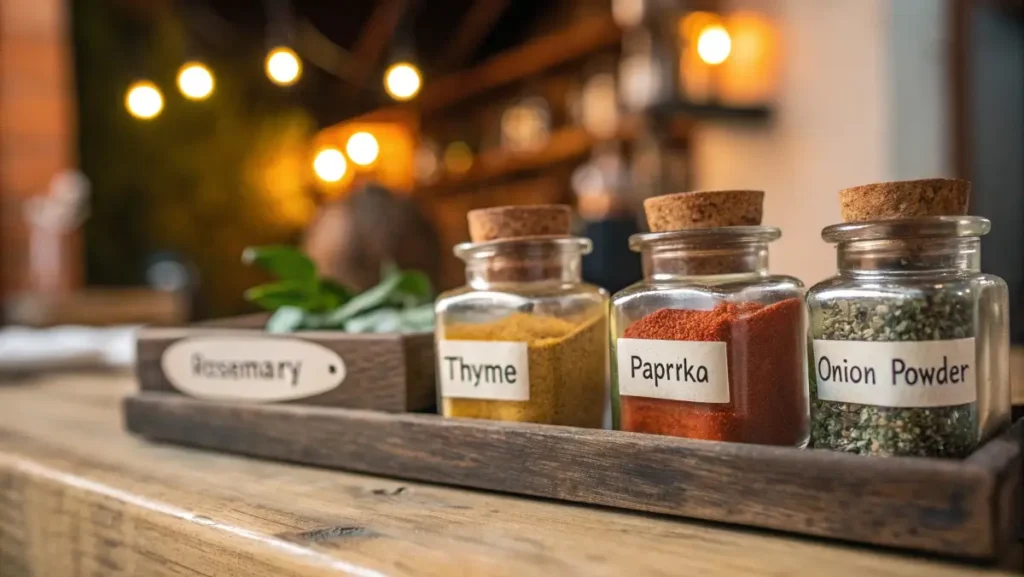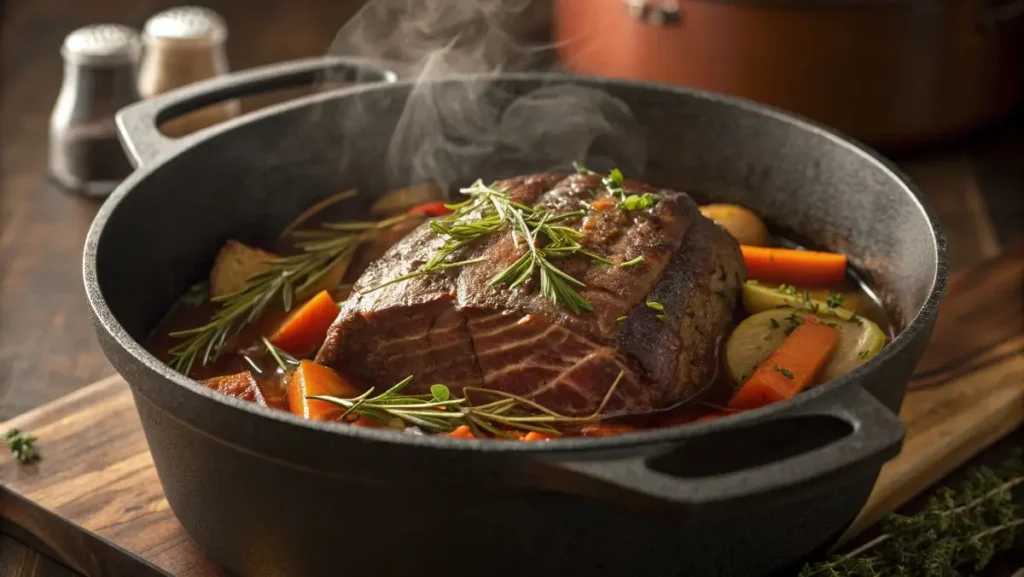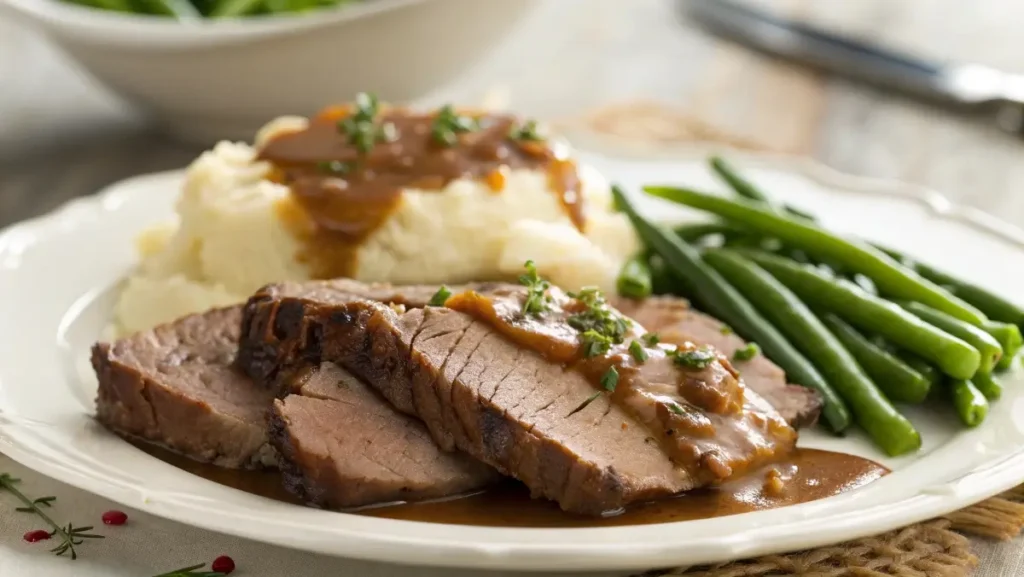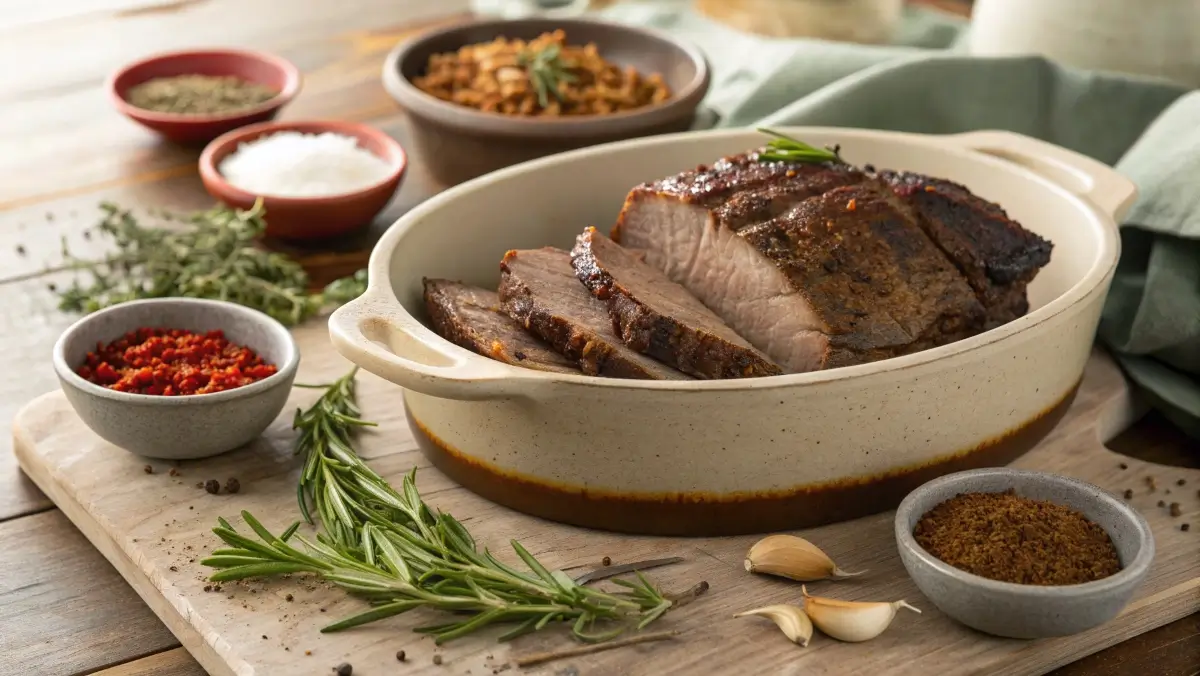Pot Roast Seasoning: The Complete Guide to Perfect Flavor
Pot roast is a comfort food classic, but the real magic lies in how you season it. A perfect blend of herbs and spices can turn a simple cut of beef into a rich, flavorful masterpiece.
The right seasoning doesn’t just add taste—it builds layers of flavor that develop over hours of cooking. From earthy herbs to bold spices, every ingredient plays a role in making each bite unforgettable.
In this guide, we’ll explore the best seasonings for pot roast, how to balance flavors, and tips to make your roast stand out. You’ll also find seasoning blends, cooking techniques, and chef-approved tricks to help you master the art of pot roast perfection.
Discover great ideas like this in our Smoked Chuck Roast Recipe for another flavor-packed beef dish.
Table of Contents
Understanding Pot Roast Seasoning Basics
What is Pot Roast Seasoning and Why It Matters
Pot roast seasoning is a carefully balanced blend of spices, herbs, and aromatics designed to bring out the rich, hearty flavors of beef. Unlike a simple salt-and-pepper rub, a good pot roast seasoning combines depth (from herbs like rosemary and thyme), warmth (from spices like paprika and garlic), and brightness (from a hint of acidity or pepper). The right seasoning can transform even the most budget-friendly cut of beef into a restaurant-worthy meal. It also helps create that signature brown crust during searing, locking in juices and building flavor layers.
How Seasoning Enhances the Flavor of Meat
Seasoning does more than just taste good—it affects how your roast cooks. Salt penetrates the meat fibers, drawing out moisture that then gets reabsorbed, making the beef juicier. Herbs and spices infuse their oils into the meat during slow cooking, creating complexity in flavor. For example, rosemary releases piney, woodsy notes, while paprika adds a subtle smokiness. A well-seasoned roast ensures every bite has balance: savory, aromatic, and mouthwatering. Even small tweaks—like using smoked salt instead of regular salt—can elevate the flavor dramatically.
Essential Spices and Herbs for Pot Roast Seasoning
Core Ingredients in Classic Pot Roast Seasoning
The backbone of any great pot roast seasoning starts with a few tried-and-true ingredients that deliver consistent flavor. Salt is non-negotiable—it enhances natural beef flavors and helps tenderize the meat. Black pepper adds mild heat and depth, working in harmony with salt to create a balanced base. Garlic powder and onion powder are flavor multipliers, adding a savory backbone that blends seamlessly into the roast’s juices. Paprika—especially smoked paprika—introduces a subtle sweetness and smokiness that elevates the dish. For complexity, a pinch of mustard powder or cumin can deepen the flavor profile, making your pot roast taste like it’s been perfected over generations.
Here’s a quick table of classic seasonings and their roles:
| Ingredient | Flavor Role | Best Pairing With |
|---|---|---|
| Salt | Enhances natural flavors | All beef cuts |
| Black pepper | Mild heat, depth | Rosemary, garlic |
| Garlic powder | Savory, aromatic | Thyme, onion powder |
| Onion powder | Sweet, earthy | Carrots, potatoes |
| Paprika | Sweet, smoky undertone | Cumin, bay leaves |
Best Herbs to Complement Slow-Cooked Beef
While spices provide warmth and depth, herbs deliver freshness and aromatic lift. Rosemary is a classic—it’s bold enough to stand up to rich beef, with pine-like notes that perfume the whole dish. Thyme is another must-have, offering a subtle herbal sweetness that works beautifully in long cooking times. Bay leaves add an earthy, almost floral aroma to the braising liquid, and parsley brings a fresh, clean finish to cut through richness. If you want to experiment, try oregano for a Mediterranean twist or sage for a deeper, wintery flavor.
For the most aromatic results, use fresh herbs when possible, but dried herbs are perfectly fine if that’s what you have—just remember to reduce the quantity, since dried herbs are more concentrated.
Check out our Homemade Chicken Taco Seasoning for more ideas on balancing spices for maximum flavor.
Creating Your Own Homemade Pot Roast Seasoning Blend

Step-by-Step Guide to Mixing Pot Roast Seasoning at Home
Making your own pot roast seasoning at home gives you full control over flavor balance, salt content, and freshness. Here’s a tried-and-true blend that works for a 3–4 lb roast:
Ingredients:
- 2 tablespoons kosher salt
- 1 tablespoon black pepper
- 2 teaspoons garlic powder
- 2 teaspoons onion powder
- 1 teaspoon smoked paprika
- 1 teaspoon dried rosemary, crushed
- 1 teaspoon dried thyme
- ½ teaspoon mustard powder
Instructions:
- Measure precisely – Too much salt or spice can overpower the beef, so stick to the ratios.
- Crush herbs for release – If using dried rosemary or thyme, crush them between your fingers before adding them to the mix to release their oils.
- Blend evenly – Use a small bowl and whisk or spoon to combine all ingredients until uniform in color and texture.
- Test the seasoning – Sprinkle a pinch on a piece of bread or potato, then cook and taste. Adjust salt or spice levels if needed.
- Apply liberally – Pat your roast dry, then coat all sides with the seasoning blend before cooking.
Storage Tips to Keep Your Blend Fresh and Aromatic
Homemade seasoning blends are best stored in airtight containers away from light and moisture. A small glass jar with a tight lid works perfectly. Keep it in a cool, dark pantry—not above the stove, where heat can degrade flavors. For maximum freshness, use the blend within 3–4 months, as ground spices lose potency over time. If you make larger batches, consider vacuum-sealing or storing portions in smaller containers to minimize exposure to air each time you open it.
Pro tip: Label your jar with the blend name and date of creation, so you always know when it’s time to make a fresh batch.
Pot Roast Seasoning Techniques for Maximum Flavor
How to Season a Roast Before Cooking
The way you season your pot roast can make the difference between “good” and “can I have seconds?” Always start with a dry surface—pat your beef roast with paper towels to remove excess moisture. This allows the seasoning to adhere better and promotes a golden-brown crust during searing. Coat the roast generously with your seasoning blend, pressing it into the meat rather than just sprinkling it on top. If possible, let the seasoned roast rest at room temperature for 20–30 minutes before cooking; this helps flavors penetrate more deeply and ensures even cooking.
For even bolder results, you can season your roast the night before, wrap it tightly in plastic wrap, and refrigerate it overnight. This “dry brining” process not only boosts flavor but also helps retain moisture during slow cooking.
The Role of Marinating and Dry Rubs in Flavor Development
Dry rubs are the most common choice for pot roast—they’re easy, mess-free, and perfect for slow cooking. The spice blend forms a flavorful crust during searing, locking in juices and creating a rich base for your gravy.
Marinades, on the other hand, use a combination of acidic ingredients (like vinegar, wine, or citrus juice) and seasonings to break down muscle fibers and infuse flavor. While marinades can be great for tougher cuts, they require more time—usually 6 to 12 hours—and can soften the meat’s exterior if left too long.
For the ultimate flavor payoff, you can combine the two methods: marinate the roast briefly to tenderize it, then pat it dry and apply a dry rub before searing. This layered approach ensures both deep flavor penetration and a delicious crust.
Don’t miss our Smoked Chuck Roast Recipe to see a dry rub in action for a different cooking style.
Regional and Cultural Variations in Pot Roast Seasoning
American-Style Seasoning Profiles
In the U.S., pot roast seasoning tends to lean toward comfort-food classics—think garlic powder, onion powder, black pepper, and dried herbs like thyme and rosemary. Some American cooks also add a pinch of brown sugar or Worcestershire sauce for depth and a touch of sweetness. In the South, you might find paprika-heavy rubs or the addition of cayenne pepper for a subtle kick. Midwest versions often incorporate hearty vegetables like carrots, celery, and onions directly into the braising liquid, letting their flavors mingle with the beef.
International Flavors and Unique Spice Combinations
Different countries put their own spin on pot roast seasoning, introducing exciting twists:
- French Pot-au-Feu: Often uses bouquet garni (a bundle of fresh thyme, parsley, and bay leaves) along with cloves studded into onions for a subtle spice aroma.
- Italian Brasato al Barolo: Features garlic, rosemary, and a splash of red wine, sometimes with a hint of cinnamon for warmth.
- German Sauerbraten: Uses vinegar, juniper berries, and cloves for a tangy, aromatic profile.
- Mexican-Inspired Roast: Incorporates cumin, chili powder, and oregano for a smoky, earthy flavor.
- Middle Eastern Version: Adds allspice, cardamom, and cinnamon for a fragrant, warming effect.
Adapting your seasoning to different cultural flavor profiles can transform the familiar pot roast into something completely new. Pairing these variations with their respective side dishes—like crusty French bread or fluffy basmati rice—can make your meal even more memorable.
Looking for inspiration? Try our Homemade Chicken Taco Seasoning for a spice profile that can inspire a Mexican-style pot roast.
Cooking Methods and Their Impact on Seasoning

Slow Cooker vs. Oven vs. Pressure Cooker Flavor Retention
Different cooking methods influence how your pot roast seasoning develops over time.
- Slow Cooker: Perfect for set-it-and-forget-it cooking, the low and steady heat allows flavors to meld gradually. Herbs and spices soften, and even tough cuts turn tender. However, you might lose a bit of brightness in delicate herbs, so consider adding fresh herbs near the end of cooking.
- Oven Roasting: Offers more control over browning and crust formation. Starting with a high-heat sear in a Dutch oven before slow baking locks in seasoning and creates a rich caramelized flavor.
- Pressure Cooker (Instant Pot): Great for speeding up the process while still producing tender beef. Because cooking time is shorter, seasonings retain more of their original punch, but subtle flavors may not develop as deeply as in slow cooking.
Choosing your method depends on whether you value depth of flavor (slow cooker/oven) or speed and intensity (pressure cooker).
Adjusting Seasoning Quantities for Each Method
The cooking method affects how much seasoning you need.
- Slow Cooker: Flavors mellow over time, so you might need an extra pinch of salt or spices at the end to brighten the dish.
- Oven Roasting: Usually requires less adjustment—what you season before cooking tends to hold its character.
- Pressure Cooker: Since flavors remain concentrated, avoid over-salting. Instead, add bold spices like smoked paprika or cumin at the start and finish with fresh herbs afterward.
Pro tip: For any method, keep some seasoning blend reserved for a post-cook sprinkle to refresh flavors before serving.
Storing and Preserving Seasoned Pot Roast
Best Practices for Refrigeration and Freezing
Once your pot roast is cooked, storing it correctly ensures you don’t lose flavor or texture.
- Refrigeration: Allow the roast to cool slightly before placing it in an airtight container with its juices or gravy. Store in the refrigerator for up to 4 days. Keeping the roast in its cooking liquid prevents the meat from drying out and helps the seasoning continue to infuse.
- Freezing: For longer storage, portion the roast into meal-sized servings, include some of the juices, and freeze in airtight freezer bags or vacuum-sealed packs. Frozen pot roast stays fresh for up to 3 months. To thaw, move it to the fridge for 24 hours before reheating.
Maintaining Flavor in Leftover Seasoned Meat
Seasoned pot roast can actually taste better the next day as the flavors meld even further. However, improper reheating can dull spices or dry the meat. For best results:
- Reheat slowly over low heat in a covered pan with a splash of beef broth to maintain moisture.
- Avoid microwaving on high heat—this can make the meat tough and unevenly heated.
- If reheating in the oven, cover the roast with foil and warm at 300°F until heated through.
For leftover seasoning blends, store them in airtight glass jars away from heat and sunlight. Properly stored, they remain potent for 3–4 months before they start losing their punch. Always label your jars with the blend name and date of creation.
Discover great ideas like our Smoked Chuck Roast Recipe for using leftover roast in new dishes.
Common Mistakes to Avoid When Seasoning Pot Roast
Overseasoning or Underseasoning Your Roast
Finding the right balance of flavor is key. Too much salt can overpower the natural taste of beef, while too little seasoning can leave the roast bland. A good rule of thumb is about 1 teaspoon of kosher salt per pound of meat, adjusting based on personal taste and dietary needs. Always taste your seasoning blend before applying it—spices can be more potent than expected, especially if freshly ground.
Ignoring Meat Type and Cut When Seasoning
Not all beef cuts absorb seasoning the same way.
- Chuck roast (the most common for pot roast) has more marbling, so it benefits from bolder, earthy spices like smoked paprika, cumin, and rosemary.
- Brisket works beautifully with sweeter notes like brown sugar or cinnamon.
- Bottom round roast is leaner, so it needs a bit more fat or oil in the seasoning mix to help flavors penetrate and prevent dryness.
Failing to adjust seasoning based on the cut can result in either underwhelming flavor or an overpowering spice profile.
Check out our Chicken Wings for more seasoning balance tips that also apply to beef roasts.
Expert Tips for Elevating Your Pot Roast Flavor

Chef-Approved Pot Roast Seasoning Hacks
Professional chefs often layer flavors at different stages of cooking for maximum impact. Start by seasoning generously before searing to create a flavorful crust, then add aromatics like garlic, onions, and fresh herbs during the braising process. Near the end of cooking, introduce bright finishing touches—such as fresh parsley, a squeeze of lemon juice, or a splash of red wine vinegar—to wake up the flavors. Using high-quality sea salt or freshly cracked pepper can make a surprisingly big difference, as pre-ground spices tend to lose potency over time.
Pairing Side Dishes to Complement Your Pot Roast Seasoning
The sides you choose can either enhance or compete with your roast’s flavor. Creamy mashed potatoes soak up savory gravy beautifully, while roasted root vegetables echo the earthy tones of your seasoning. A fresh green salad with a tangy vinaigrette can cut through the richness, balancing the meal. Bread lovers might opt for crusty rolls or cornbread to mop up every drop of the seasoned juices. Even simple steamed green beans with a bit of garlic butter can provide a crisp, fresh contrast to the deep, savory flavors of your pot roast.
Don’t miss our Smoked Chuck Roast Recipe for another hearty, flavor-packed beef option.
Conclusion
Seasoning a pot roast is about more than just sprinkling spices—it’s about creating depth and balance from start to finish. With the right blend, your roast will be tender, aromatic, and packed with flavor.
The key is to start strong with a good sear, layer in aromatic herbs and spices, and let time do the rest. Don’t forget to finish with fresh herbs or a splash of acidity to keep flavors bright.
Follow these tips, and your pot roast won’t just be another dinner—it’ll be the dish everyone asks for again and again.
Looking for inspiration? Try our Homemade Chicken Taco Seasoning to explore more creative spice blends for your kitchen.
FAQs
What seasonings do you put on pot roast?
A classic pot roast seasoning blend usually includes salt, black pepper, garlic powder, onion powder, dried thyme, rosemary, and paprika. Some cooks add Worcestershire sauce, soy sauce, or a touch of brown sugar for depth and complexity.
What spices go well with a roast?
In addition to the basics like salt and pepper, warm spices such as smoked paprika, cumin, and coriander work well. For a more aromatic profile, add bay leaves, cloves, or allspice. These spices enhance the beef’s natural richness without overpowering it.
How do you add flavor to pot roast?
Flavor starts with a good sear on the meat to create a crust that locks in juices. Using fresh aromatics like onions, carrots, and celery adds natural sweetness. Adding wine, broth, or beer during cooking infuses moisture and complexity into the roast.
How do you season a roast before cooking?
Pat the meat dry to help the seasoning stick, then rub it generously with your spice blend, making sure to coat all sides. Let the meat rest for 15–30 minutes after seasoning to allow the flavors to penetrate before searing or roasting.
What is the best way to add flavor to roast meat?
Searing the meat in hot oil before slow cooking is one of the best ways to build flavor. Using a mix of fresh herbs and dried spices ensures layers of taste, while finishing with fresh seasonings or acidic ingredients keeps the flavors vibrant.
How should I season roast beef?
Season roast beef with a balanced blend of salt, pepper, and aromatics. Adjust based on the cooking method and beef cut. Bold cuts like chuck can handle stronger spices, while leaner cuts benefit from milder seasonings paired with a bit of fat for richness.

